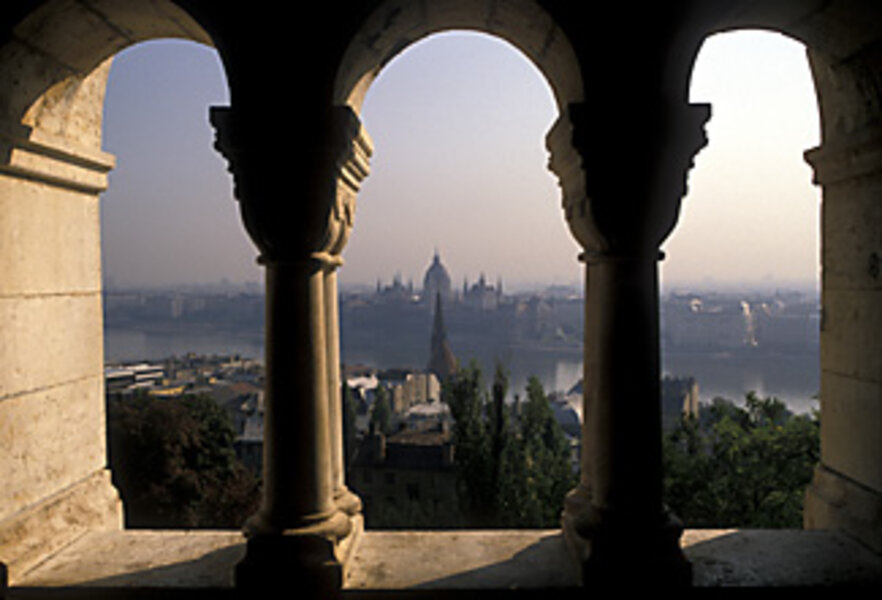Suburban sprawl pollutes Hungary
| Budapest, Hungary
Climb into the Buda Hills and look back at the flatlands of Pest and the pollution is obvious: a yellow-gray cloud that blankets the Hungarian capital much of the time.
Indeed, 19 years after the collapse of communism, Budapest's air quality has become a problem again. Pollution exceeded recommended levels 115 days last year, 80 days more than permitted under European Union (EU) guidelines. In late December and early January, the capital experienced one of its most prolonged smog events in a decade.
When communism imploded in 1989, Budapest's air was atrocious. With their two-cycle engines, fleets of Trabant automobiles spewed black clouds of lead-laden exhaust, while city busses and industrial facilities pumped eye-stinging emissions into the air. During the 1990s the air cleared as factories installed pollution controls, leaded gasoline was banned, and newer, cleaner Western cars replaced dirty Soviet ones.
But in recent years, those gains have been reversed as many Hungarians now drive to work from increasingly far-flung suburban areas. Lead and sulfur dioxide have been replaced by dangerous concentrations of tiny exhaust particles.
"We've exchanged [Victorian-era] London-type smog for Los Angles-type smog," laments Janos Zlinszky of the Regional Environmental Center for Central and Eastern Europe. "The nature of our environmental problems is shifting."
Across east-central Europe, a region once blighted by Communist-era pollution, economic development is bringing on a new set of environmental problems and, in some cases, bringing back old ones.
The not-so-blue Danube?
The Danube River, an 1,800-mile waterway that drains half of the European continent, has gotten much cleaner since 1990, when its heavy load of sewage and agricultural runoff helped trigger the ecological collapse of much of the Black Sea. The improvement was due mostly to the end of Communist-era agriculture in Hungary, Romania, and Bulgaria, though new sewage treatment plants helped as well.
As a result, experts say, the Black Sea ecosystem is beginning to show signs of recovery.
"The Black Sea does appear to be experiencing some positive ecological effects from the reduced pollution trends," says Philip Weller, executive secretary of the Vienna-based International Commission for the Protection of the Danube River.
But Mr. Weller is concerned that those gains will soon be lost as the region's economy grows and Romania and Bulgaria move toward more intensive agriculture in the Danube's lower watershed. "If more fertilizers and pesticides are utilized, there will be an increase in pollution in the rivers," he notes. "We're already see the positive trends leveling off."
In Poland, EU membership has brought a flood of truck traffic pouring over its once-quiet eastern borders with Lithuania and Belarus. The government's solution – to build a highway through the Rospuda forest, one of Europe's last wild places – triggered an outcry from environmentalists across the continent. The European Commission has asked the European Court of Justice to block the highway, saying it would destroy primeval forests and wildlife habitat of continental significance.
"Those promoting these big infrastructure projects don't recognize that nature has nowhere else to retreat," says Mr. Zlinszky.
Industry vs. agriculture
Other developments are pitting EU member countries against one another.
Earlier this month, Slovakia abandoned plans to build a coal-fired power plant because of opposition from Hungary, which feared damage to the neighboring Tokaj grape-growing region, a UNESCO World Heritage site. Hungarian President Laszlo Solyom has criticized Austria for failing to stop its tanneries from polluting the Raba, a river shared by both countries.
Budapest's worsening air pollution is due in large part to the advent of American-style suburban housing developments and shopping centers, according to Andras Lukacs, president of the Clean Air Action Group. "Several hundred thousand people have moved out of central Budapest and gone to these new so-called residential parks in what used to be green areas," he says. "Each day they come back to their jobs here, but because public transportation isn't so good out there, they take their cars."
Hungarians now own 3 million passenger cars, nearly twice as many as in 1989, according to government figures. "Traffic is the main air quality problem," says Mr. Lukacs.
Increased natural gas prices are causing trouble, too, prompting cash-strapped homeowners to heat with wood or coal instead. "These fuels are cheaper, but they're much more harmful from the environmental point of view," says Judit Varga of the Ministry of Environment and Water, who says many apartment buildings are now trying to disconnect themselves from Budapest's gas-fired district heating plants.
Lukacs says cleaning up the city's air will require a combination of better land use planning, lower ticket prices for public transportation, and the introduction of congestion tolls and higher parking fees in the city center. "It's about reducing traffic and increasing public transport use," he says.





